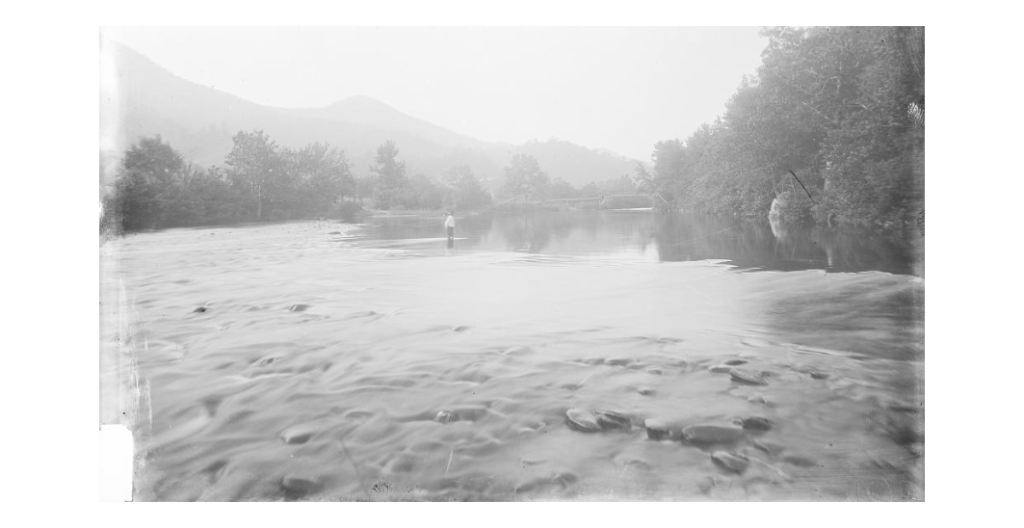A Small River or Creek
By Quale-U-Quah[1]
Annotations by Jessica cory

There is a small river which runs along about a mile from my home; it is a very beautiful one; its banks are covered with large fine trees, grass and various kinds of flowers. In the spring, it is very pleasant to sit on the bank and look at the water gliding along. Many a happy hour I have passed at this creek with my sisters and schoolmates, looking at the water and gathering flowers, making boquets [sic] and gathering grapes and berries. There are a great many fine nut trees on the bank with their large branches hanging over the water. A little way up the creek is a mountain. It has some large rocks on it. When we go on the top of the mount [sic] and get on one of these large rocks and look down on the creek running below, it is very beautiful. There is one place at this mountain where there is a way to go down like steps, and the rocks are placed one after another, and look as if some one [sic] had made them that way. Between some large rocks, there is a place almost in the shape of a house. It is square just like a room, and it has a beautiful spring in it, and the water come from out the rock, runs down to the bottom and goes into the creek. It makes a great noise when it falls off the rock. There is an open place like a door, and just in front of the door is the creek. It is pleasant to sit in there and see every thing [sic] looking so fresh and beautiful.
Quale-u-quah. “A small river or creek.” A wreath of cherokee rose buds 1, no. 2 (august 1854): 4.
[1] While some residential schools at the time kept and have digitized student records, no information is available regarding Quale-U-Quah’s tribal affiliation or identity beyond just her name.
Contexts
This piece first appeared in A Wreath of Cherokee Rose Buds, a publication of the first Cherokee Female Seminary. The seminary, which opened in 1851, was a residential school for female Native American students in the U.S. located in Park Hill, Oklahoma, just outside of Tahlequah (the capital of the Cherokee Nation). The seminary (and other similar seminaries, many of which were for males) differed significantly from the industrial boarding schools for Native youth. While still teaching many subjects to encourage assimilation and refusing to teach the Cherokee language or culture, the seminaries’ curriculums were what we might think of today as college prep, rather than readying students for occupational labor. The student body also contrasted with boarding schools, as seminary enrollment was optional, tuition was expensive, and students generally came from upper-class and mixed-blood backgrounds.
Because of the residential nature of the seminary and the fact that it accepted students from many tribes, some of whom may have been far from home, the longing for familiar landscapes expressed by Quale-U-Quah was likely also felt by other students. Unfortunately, because there is no available biographical information about Quale-U-Quah, we can’t know more about the place she called home.
The Youth’s Companion published this piece on September 7, 1854, as “A Small River” in the “Indian Youth’s Newspaper” section.
Resources for Further Study
- Several websites discuss the history of the first Cherokee Female Seminary, including Mount Holyoke’s website. For an overview of the Cherokee male and female seminaries, the Oklahoma Historical Society’s website is helpful.
- The Tahlequah Daily Press discusses the impact of the Cherokee Female Seminary on the surrounding areas.
When learning or teaching about Cherokee history, it can be easy to get caught up in Removal (also known as the Trail of Tears) or other atrocities which the Cherokee faced. However, it’s important to also teach about Cherokee recovery and resistance. The Cherokee are still here, and that recovery and resistance in the face of settler colonialism and genocide is the reason why.
- The Association for Core Texts and Courses offers many wonderful materials to teach about the Cherokee from pre-contact through contemporary art and culture, focusing on reclamation and renewal.
- The Zinn Education Project, named after Howard Zinn, author of A People’s History of the United States, offers a treasure trove of history and social studies lessons for all grades. Here are some for teaching about Native Americans, including this activity, which analyzes Andrew Jackson’s speech about Removal from a critical perspective.
Contemporary Connections
The rebuilt Cherokee Female Seminary (reconstructed at a different site after an 1887 fire ruined the original) is now part of the Northeastern State University campus known as Seminary Hall. The Cherokee Heritage Center now sits on the original Park Hill site. The rebuilt seminary is also on the National Register of Historic Places.